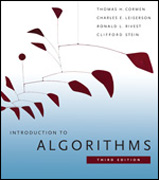
Introduction to algorithms
Cormen, Thomas H.
Leiserson, Charles E.
Rivest, Ronald L.
Stein, Clifford
Some books on algorithms are rigorous but incomplete; others cover masses of material but lack rigor. Introduction to Algorithms uniquely combines rigor and comprehensiveness. The book covers a broad range of algorithms in depth, yetmakes their design and analysis accessible to all levels of readers. Each chapter is relatively self-contained and can be used as a unit of study. The algorithms are described in English and in a pseudocode designed to be readable byanyone who has done a little programming. The explanations have been kept elementary without sacrificing depth of coverage or mathematical rigor. The firstedition became a widely used text in universities worldwide as well as the standard reference for professionals. The second edition featured new chapters on the role of algorithms, probabilistic analysis and randomized algorithms, and linear programming. The third edition has been revised and updated throughout. It includes two completely new chapters, on van Emde Boas trees and multithreaded algorithms, and substantial additions to the chapter on recurrences (now called "Divide-and-Conquer"). It features improved treatment of dynamic programming and greedy algorithms and a new notion of edge-based flow in the material on flow networks. Many new exercises and problems have been added for thisedition. As of the third edition, this textbook is published exclusively by the MIT INDICE: Introduction. The Role of Algorithms in Computing. Algorithms Algorithms as a technology. Getting Started. Insertion sort Analyzing algorithms. Designing algorithms. Growth of Functions. Asymptotic notation. Standard notations and common functions. Divide-and-Conquer. The maximum-subarray problem Strassen's algorithm for matrix multiplication. The substitution method for solving recurrences. The recursion-tree method for solving recurrences. The mastermethod for solving recurrences. Proof of the master theorem. Probabilistic Analysis and Randomized Algorithms. The hiring problem Indicator random variables. Randomized algorithms. Probabilistic analysis and further uses of indicatorrandom variables. II Sorting and Order Statistics. Introduction Heapsort. Heaps Maintaining the heap property Building a heap. The heapsort algorithm. Priority queues. Quicksort. Description of quicksort. Performance of quicksort. Etc
- ISBN: 978-0-262-03384-8
- Editorial: MIT
- Encuadernacion: Rústica
- Páginas: 1292
- Fecha Publicación: 01/09/2009
- Nº Volúmenes: 1
- Idioma: Inglés
